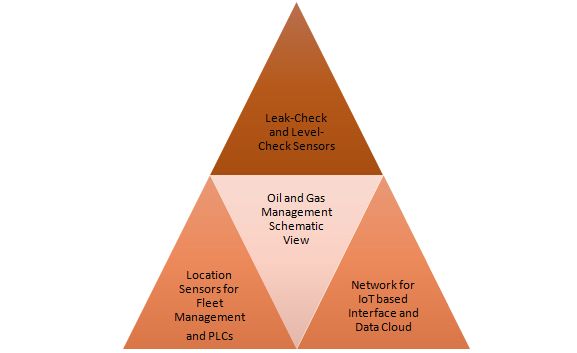
Imagine if we can retrieve information from sensors, assess it in the cloud, transmit and receive the data through machines? The world we are living in right now, would be much streamlined.
There has been a rapid growth of the IoT in various sectors among the world. Oil and Gas (O&G) is one of the most pliant sectors when the world brings forth the new era of technology and automation. Yet, the technological advancements in this sector have been the least, substantially ascribed to quaint and inefficacious approach that many companies apply.
IoT, on the other hand, helps industries in management and evaluation of data.
Be it leakage monitoring, fleet management for transportation, or pressure monitoring, IoT paves a way for all the panacea in the Oil and Gas field.Drilling, transportation, quality assurance are the key aspects for a basic well-driven Oil and Gas Industry, as well as potential threats.
Oil and Gas as resources have been availablesince the age of dawn. Since understanding its multiple uses as a fuel, large scale business houses have joined together to extract and use it for their benefit. End-users of crude oiland its widespread applications are global. In such a scenario, the introduction of technology, in the form of IoT is quintessential and comes handy.
How will IoT decipher this conundrum?
There are various implementations in Oil and Gas Industry which require constant monitoring over time. IoT helps building an entirely new asset for indirectly managing their existing assets, supply chains and consumer relationships. But, IoT in industries might definitively help in optimizing control, improvising reliability and providing and entirely new mode of cataloguing and accessing data.
(1) Predictive Analysis– Redefining the methodologies of the current working ecosystems of Oil and Gas industry, Big Data, along with the IoT, can bear reliability. It would be a gateway to provide insights about the working conditions of pumps and valves. The IoT initialized sensors can catalogue and analyze data to predict future maintenance and breakdown at one go.
(2) Low Power Wide Area Network– The LPWAN could be highly essential in fabricating M2M communications. With all the IoT based sensors and interfaces required for real time updates inclusive of leak-check, level-check sensors, determining and transmitting the information through the data cloud. The cost effectiveness of such a network becomes an essential requirement, which is typically served by Internet of Things. Also PLC (Programmable Logic Controller) Systems are wired IoT devices to collect data over the wires, which one finds pricey, which makes it highly irrelevant to cost-effectiveness.
(3) Supply Chain Management– Transparency and authenticity are prime elements when there is a rotation of resources from one site to another. The industries, as well as the end-users, find it highly obligatory to understand and acknowledge the basic requirements of oil and gas business. Connectivity, for everyone- transportation trucks to board-room members, is vital to enrich and grow the business towards a simplified, yet competent environment.
(4) Reduction in Maintenance Costs and Pricing– For the industries as premier agents in oil management systems, it is essential again to maintain and tract the costs required for repairs and maintenance. Due to IoT, there has been a significant cut-off (15-25%) in the foremost and inceptive maintenance costs. It has converted the former to a condition-based ecosystem where maintenance and repairs are primarily based on the IoT based interface and sensing devices.

(Possible Descriptive Analogy for an O&G Management Schema)
How does IoT prove its effectiveness to Businesses?
Assimilation of the Miscellaneous Data Rolls-For the businesses related to O&G, the astounding plunge of prices in Crude Oil resulted in businesses running out of their secure assets. The IoT aids them by successful management of resources, optimal realization of pricing and involvement of real-time updates about the supply management and machinery.
Quality Regulation-Efficiency and fidelity is rare, but highly appreciable ethic in an O&G industry. For every E&P (Exploration and Production) company in the O&G business, it is an eminent job to manage the quality control. Increasing production along with improvising the quality of the seismic rocks found under the bed, IoT-based mechanisms could curb the pathways alongside.
Pricing Management- Via connected wireless devices, the IoT turns out to be an indispensable entity. It assists the industries as well as the end users to deal with the sudden hike in the prices of the primary sector along with the tertiary sector. It helps one deal with the premier maintenance costs, repair management or rebuilding an entire location. It cuts-off the basic disbursements for a company by providing them with absolute transparency.
The future of IoT in Oil and Gas Industry
The evolution of Oil and Gas still persists as there is time yet to realize the full potential of Internet of Things in this industry. However, it might have altered the current reality of the industry by assisting them with systematizing the information and assessing it for the betterment of business decisions.
On a different outlook, IoT deals with the management of Crude Oil, which is an essential resource. The depletion of such a resource may arise in an ecological imbalance, which could turn out to be ravaging to the nature and the generation ahead of us.
Internet of Things, bring about the true sense of why technology must be highly administered in the modern-day enhancements of business, industries and people around the world.
Sanjeev is the Chief Executive Officer (CEO) of Biz4Intellia,
responsible for leading Biz4Intellia’s global business strategy and operations.
Being an Internet of Things (IoT) enthusiastic from the beginning of its
professional career, Sanjeev loves to read and write blog/articles related to
the disruptive technologies that are trending.